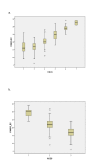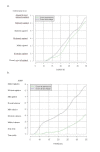Validation of the Excited Component of the Positive and Negative Syndrome Scale (PANSS-EC) in a naturalistic sample of 278 patients with acute psychosis and agitation in a psychiatric emergency room
- PMID: 21447155
- PMCID: PMC3078838
- DOI: 10.1186/1477-7525-9-18
Validation of the Excited Component of the Positive and Negative Syndrome Scale (PANSS-EC) in a naturalistic sample of 278 patients with acute psychosis and agitation in a psychiatric emergency room
Abstract
Background: Despite the wide use of the Excited Component of the Positive and Negative Syndrome Scale (PANSS-EC) in a clinical setting to assess agitated patients, a validation study to evaluate its psychometric properties was missing.
Methods: Data from the observational NATURA study were used. This research describes trends in the use of treatments in patients with acute psychotic episodes and agitation seen in emergency departments. Exploratory principal component factor analysis was performed. Spearman's correlation and regression analyses (linear regression model) as well as equipercentile linking of Clinical Global Impression of Severity (CGI-S), Agitation and Calmness Evaluation Scale (ACES) and PANSS-EC items were conducted to examine the scale's diagnostic validity. Furthermore, reliability (Cronbach's alpha) and responsiveness were evaluated.
Results: Factor analysis resulted in one factor being retained according to eigenvalue ≥1. At admission, the PANSS-EC and CGI-S were found to be linearly related, with an average increase of 3.4 points (p < 0.001) on the PANSS-EC for each additional CGI-S point. The PANSS-EC and ACES were found to be linearly and inversely related, with an average decrease of 5.5 points (p < 0.001) on the PANSS-EC for each additional point. The equipercentile method shows the poor sensitivity of the ACES scale. Cronbach's alpha was 0.86 and effect size was 1.44.
Conclusions: The factorial analyses confirm the unifactorial structure of the PANSS-EC subscale. The PANSS-EC showed a strong linear correlation with rating scales such as CGI-S and ACES. PANSS-EC has also shown an excellent capacity to detect real changes in agitated patients.
Figures



References
-
- Allen MH, Currier GW, Hughes DH, Reyes-Harde M, Docherty JP. Expert Consensus Panel for Behavioral Emergencies, 2001. The Expert Consensus Guidelines Series. Treatment of behavioural emergencies. Postgraduate Medicine. 2001. pp. 1–88. quiz 89-90. - PubMed
-
- Kay SR, Fiszbein A, Opler LA. The positive and negative syndrome scale (PANSS) for schizophrenia. Schizophrenia Bulletin. 1987;13:261–276. - PubMed
Publication types
MeSH terms
Substances
LinkOut - more resources
Full Text Sources
Other Literature Sources
Medical

